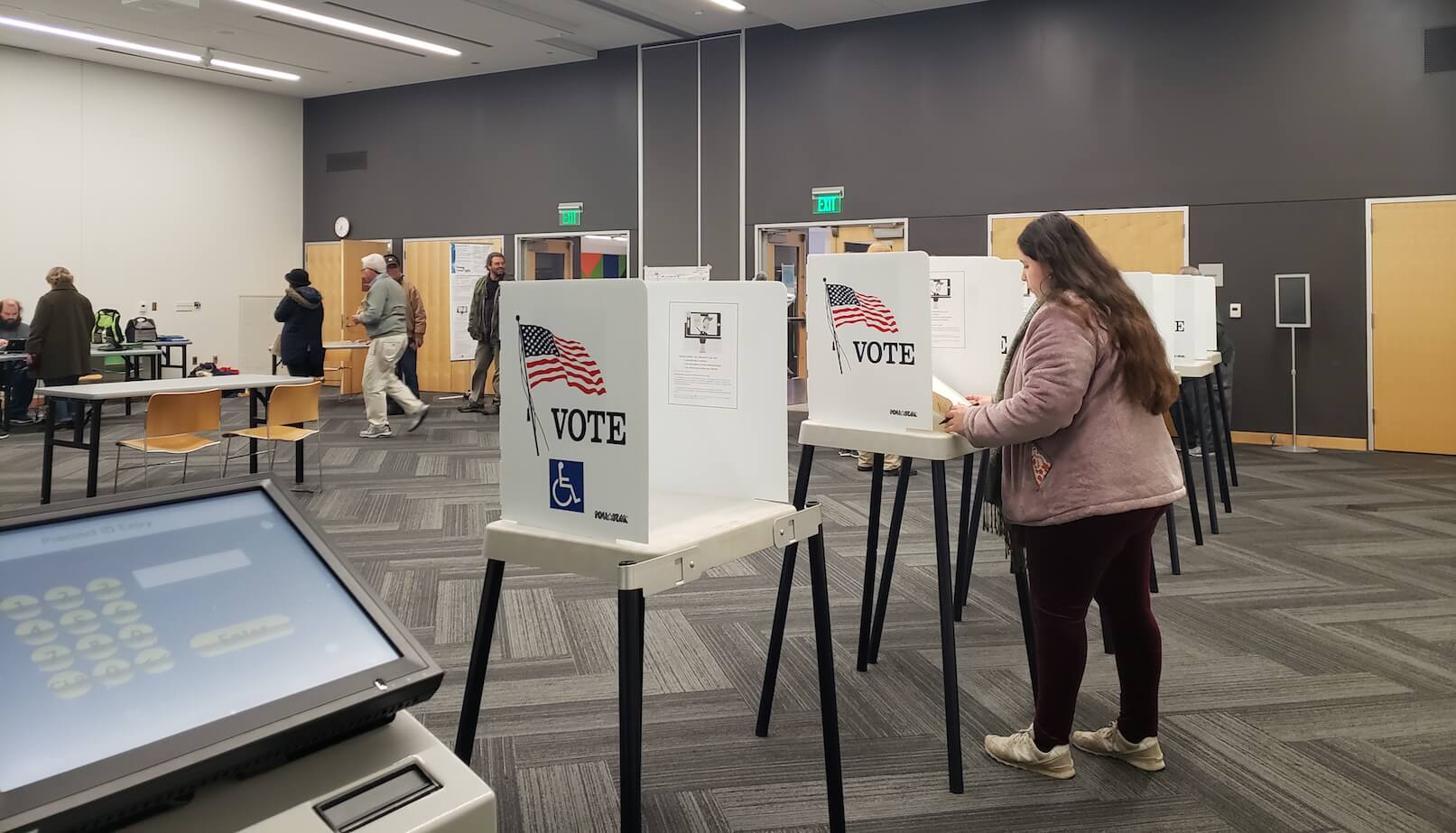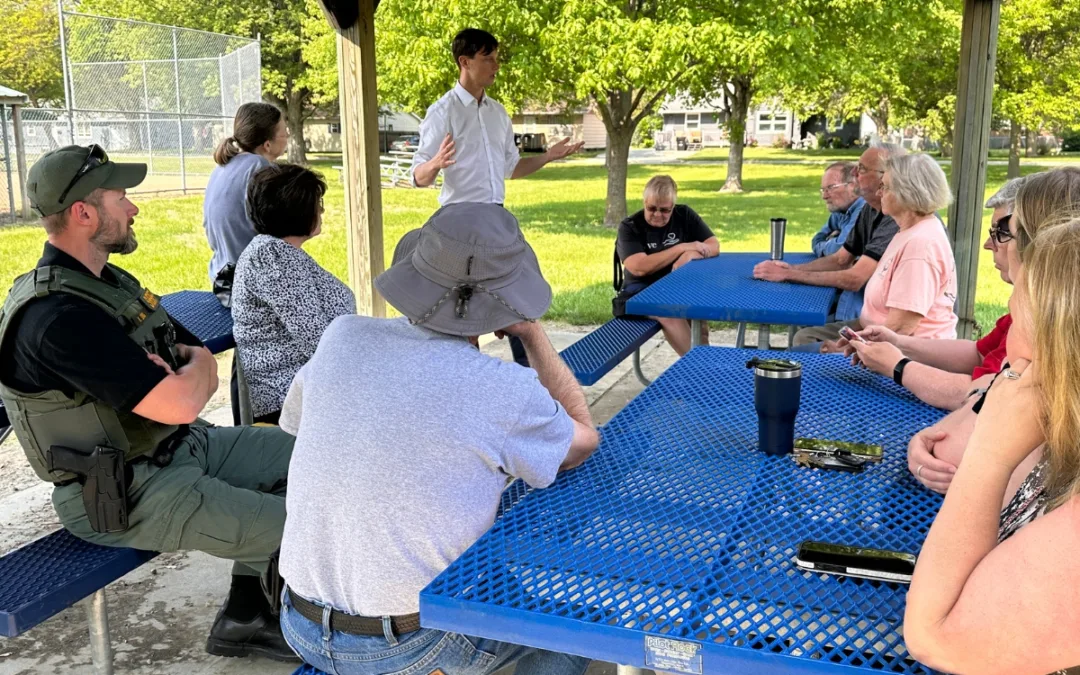
Although the new voter ID law was fully in effect in Iowa today, voters found ways to cast a ballot at polling sites this reporter visited in Polk and Story counties with the help of poll workers.
On its face, the law is relatively simple. Show an accepted form of ID, the poll workers scan it, you confirm some information, you get a receipt to sign and turn it in for a ballot.
Of course, reality is usually more complicated.
And in four different polling places in Des Moines and Ames, poll workers handled those complications and made sure every voter marked a ballot.
Voter ID in Practice
In Iowa, voters can use an Iowa driver’s license or non-operator ID, U.S. passport, U.S. military ID or veteran’s ID, tribal ID/document or Iowa voter ID card.
For this election, polling places in Story and Polk County had iPads to scan IDs and walk poll workers through checking people in to vote.
The machines are programmed with all of the information the poll workers need, including the acceptable IDs and what steps to take if a voter doesn’t have them.
By 2 p.m., poll workers at Union Drive Community Center in Ames didn’t have any provisional or spoiled ballots on their hands. IDs weren’t a problem either, even if the ID wasn’t an Iowa driver’s license.
[inline-ad id=”0″]
In fact, poll workers reported they saw a number of Iowa State University students who used passports, and any student with an out-of-state driver’s licenses was quickly registered as an Iowa voter and given a ballot.
One student walked in, registered to vote in Missouri, and the poll workers helped him register in Iowa so he could cast a ballot in Ames. It took probably five minutes.
“It’s not cumbersome, not at all. What makes it easy is the machines,” said Carolyn Klaus, the precinct captain at Union Drive.
Many poll workers had praise for the computer systems.
Student Experience
At a different location in Ames, a few students walked into the polling location, glanced at the poster in the doorway and told the poll workers they didn’t know what they were doing, but they wanted to vote.
In response, the poll workers readily walked the voters through the necessary documentation, asked the students to confirm their information and handed them a ballot.
“It hasn’t been a problem and I haven’t heard anyone complain,” said Marty Miller, a poll worker at Buchanan Hall.
She said students generally know what to do, so the only part that took longer was when they had to prove residency to register. If the polling location or election were busier, Miller said, that could slow down the line.
One student who had to do that said the same thing.
Andrew Deick ended up registering to vote there at the polling place, which meant he had to prove his identity and that he lives in Iowa. Luckily, his address is in the ISU system, so he was able to confirm that through the university’s residency portal. That’s something that the local college Democrats pushed for with the university’s administration to help students vote.
“It would be a lot more convenient if I could just use my university ID,” he said. “If it would have been busier, it would have been a lot more difficult.”
[inline-ad id=”1″]
Courtney Sabotta said she registered to vote in Iowa as soon as she got to campus because she believes it’s important. At the polls, she used a plain, white voter ID card she got in the mail a week or so after registering.
“I wanted to be sure I could vote, so I signed up for that,” she said.
The cards have barcodes on the back, just like a driver’s license, so she said checking in with the card was no more difficult than if she’d had a driver’s license.
“They Were Ready”
Most of the people who showed up to vote were already reaching into their purses or wallets as they walked up to the check-in tables.
“Everybody’s been getting prepared for [voter ID],” said Bill Coil, the precinct captain at the Forest Avenue Library in Des Moines. “They were ready.”
In 2018, many polling locations asked for voter ID, but it wasn’t required. It was then that most voters who showed up that year learned about the need to show ID.
Most of the time, people showed their driver’s licenses before they needed to.
Across the four polling places, the only real problem was voters who were in the wrong place. But even then, poll workers were able to tell the voter where they should go instead, and their machines printed the address for the voter to take with them.
“Otherwise, it’s been very smooth,” Coash said.
Potential Problems Outside Cities
Poll workers in all four locations said they hadn’t experienced any issues with Iowa’s voter ID law fully implemented, but a few acknowledged that’s understandable in urban areas, where people have more access to getting IDs.
“People here have been well-educated, but that’s maybe not the case in other places,” said Kathy Berrett, a poll worker at the Union Drive polling location. “Here, it’s pretty easy for people without the information to get it.”
The other different dynamic for municipal races is the lower voter turnout, which alleviates the challenge of long lines, and the fact that most voters for these contests are more-engaged voters, who may come from backgrounds where they don’t face as many problems with lack of ID.
Thompson said the voter ID process may add some extra hurdles, but with the computer system, the ability to register people at the polls or change their information and the number of options people have for proving who they are, those hurdles aren’t significant.
“Nonetheless,” she said, “we don’t let anyone get away without voting.”
by Nikoel Hytrek
Posted 11/5/19
Politics

Biden announces new action to address gun sale loopholes
The Biden administration on Thursday announced new action to crack down on the sale of firearms without background checks and prevent the illegal...

Biden cancels student loan debt for 2,690 more Iowans
The Biden administration on Friday announced its cancellation of an additional $7.4 billion in student debt for 277,000 borrowers, including 2,690...
Local News

No more Kum & Go? New owner Maverik of Utah retiring famous brand
Will Kum & Go have come and gone by next year? One new report claims that's the plan by the store's new owners. The Iowa-based convenience store...

Here’s a recap of the biggest headlines Iowa celebs made In 2023
For these famous Iowans, 2023 was a year of controversy, career highlights, and full-circle moments. Here’s how 2023 went for the following Iowans:...





